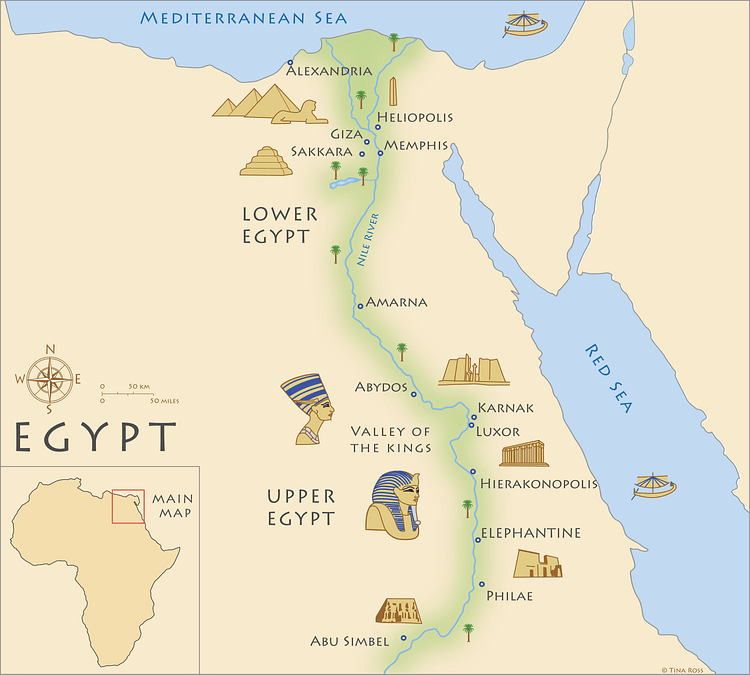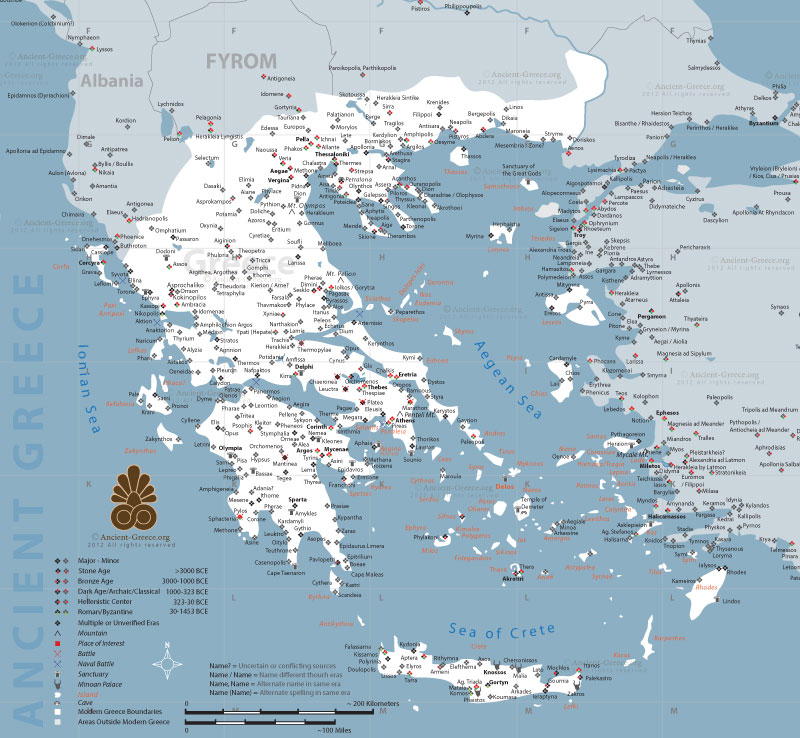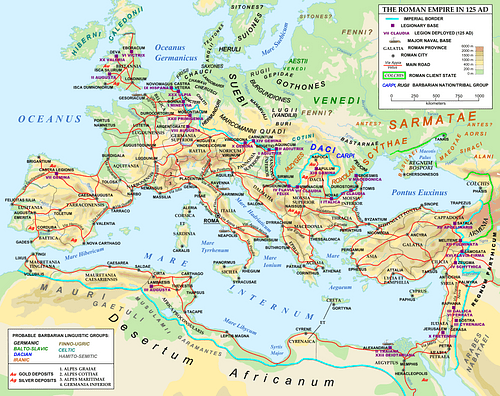Abstract
This essay argues that, while the leading powers of the archaic period eventually came to acknowledge the necessity of a strong navy, each of them demonstrated a separate range of factors contributing to the process. The list of examined nations includes Egypt, Greece, and Rome in their ancient periods. The Mediterranean Sea was at the intersection of these countries’ zones of influence. However, they pursued different routes on the path to a strong maritime presence.
For Egypt, control over its bodies of water was a matter of national survival in a difficult environment. Irrigation by the waters of the Nile, combined with occasional commercial activities in the Mediterranean, provided the kingdom with the required resources. In Greece, the maritime presence was conditioned mainly by economic factors, as the primary link between city-states divided by the terrain. In addition, the dominant poleis relied on their fleets for the purposes of defense and domination. Finally, for the Roman Empire, the creation of a strong navy became the gateway to expansion and glory. At the same time, maritime operations enabled efficient logistics within the vast Empire.
Historical Perspective
Ancient Egypt
In order to review the factors, which contributed to the development of ancient civilizations’ marine power, it is vital to establish a clear historical context. Ancient Egypt was one of the dominant nations of its time, which encompassed the period from – to – (Van De Mieroop, 2021). The nation could be considered one of the superpowers of the era due to the development of sciences, arts, architecture, and ancient technology. From a geographical perspective, the kingdoms of Ancient Egypt occupied massive territories in Northern Africa, and the nation was mainly land-based.
Nevertheless, the lives of Ancient Egyptians remained inseparable from the kingdom’s main bodies of water. First of all, while the territory of the nation was considerable, most of its population was condensed along the basin of the Nile (Figure 1). The legendary river served as the key artery and played a role of paramount importance in Egyptian culture, mythology, and folklore.

From a practical point of view, the Nile remained a convenient transportation route, as it was much easier to carry people, including soldiers, construction materials, and food by water than through a deserted landscape. In addition, the northern borders of Ancient Egypt were marked by the southern banks of the Mediterranean Sea, which was the intersection of the most developed civilizations of the time.
Ancient Greece
Greece is one of the primary aspects associated with the archaic period of civilization. Its development comprises a rather long period from the 12th century B.C. to the beginning of the 7th century A.D. Throughout its history, Ancient Greece underwent major transformations in terms of its territory and internal organization. Notwithstanding these changes, the nation is always closely connected to the sea. The Greek mainland is mountainous, which prompted its inhabitants to move closer to the shore of the Aegean and Mediterranean Seas (Lovano, 2019). Furthermore, a considerable portion of the Greek territory comprised multiple islands scattered across these bodies of water (Figure 2).

Therefore, water transportation was a key aspect of life and a matter of national security and prosperity. Lovano (2019) mentions that the advancements of Ancient Greece served as the foundation for the latter stages of humanity’s development. Democracy, natural sciences, and the arts of the world have been largely inspired by the Greek legacy. The Navy is another crucial feature of Ancient Greece’s influence, as the seafarer’s expertise contributed to the nation’s prosperity while setting the direction for future development.
Ancient Rome
Ancient Rome has rightfully claimed a place among the most significant nations in the history of the Earth. The civilization, which stemmed from the city of the same name, shortly expanded its influence to immense territories. Romans dwelled on the scientific and military expertise of their ancestors and prior civilizations, namely Greece, and developed them even further. As a result, the nation eventually became one of the largest and strongest empires in the world’s history (Zoch, 2020).
Sea travel and the navy played a pivotal role in the strength of Ancient Rome. Historically, the core of the Roman civilization comprised the Italian Peninsula, but conquest and diplomacy allowed the Empire to extend its frontiers by a fine margin. At its peak, Rome controlled the entire Mediterranean Sea, from Northern Africa to Europe and the Middle East, which was only possible through immense marine expertise (Figure 3). In addition, the Roman civilization incorporated the benefits of water into the country’s life.

Aqueducts and canals of the Empire have redefined water supply and irrigation, introducing a new era the humanity’s development. These achievements, along with the profound knowledge of ship construction and navigation, have remained impressive until today.
Characteristics and Development of the Navy
Ancient Egypt
The history of ancient Egypt comprises many centuries, during which the nation experienced significant changes. At certain points, it dominated the Mediterranean region and its vicinity, whereas, during other periods, Egypt was subjected to the influence of other civilizations. Nevertheless, the core factors, which prompted the development of the nation remained mostly unchanged. The Nile is one of the main features generally associated with the Egyptian civilization.
As such, the entire course of the kingdom’s development was projected in regard to the influence of one of the world’s mightiest rivers. Egyptian towns, villages, and temples spanned across both banks of the Nile, and its valley became the center of the nation. This status is enabled through irrigation, which played a particularly vital role (Haug, 2017).
Most of the country’s territory was occupied by infertile deserts, which made Ancient Egypt’s attraction to large bodies of water natural. Floods on the Nile provided the nation with sufficient irrigation, enhancing its otherwise poor agricultural capacity. In a way, Egyptians became the world’s pioneers of irrigation and large-scale agriculture.
Therefore, the nation depended heavily on the Nile and its properties, which explains the respect for the river embedded in Egyptian myth and chronicles. In addition to ensuring the kingdom’s sustenance through irrigation, the Nile also was the primary transport artery. Egyptians relied on it for transportation, especially during the construction of the famous pyramids and immense temples.
However, the nation also boasted expert seafarers, who embarked on long voyages through the Mediterranean and the Red Seas. However, sea travel was mostly a matter of necessity for Egypt which experienced a natural shortage of certain raw materials (Khalil, 2019). Therefore, the pursuit of new modes of trade instigated the naval expertise of Ancient Egypt.
In fact, the development of the country’s navy also depended on external contacts, as well as natural factors. Khalil (2019) mentions that the fleet of Ancient Egypt became particularly strong during the period of Ptolemaic Alexandria. At that time, the kingdom had “2,000 barges propelled by poles, 1500 galleys, warships, and 800 cabin ships” (p. 13).
Archaeological findings suggest that the construction of the Egyptian vessels varied from the medieval and modern understanding. Instead of having a skeleton for internal support, most ships of Ancient Egypt were built with a single hull. It appears nearly impossible to state whether a similar construction was used for all types of vessels. Nevertheless, despite the unusual composition, the Egyptian navy remained capable of prolonged missions, as well as effective defense of the nation (Westphalen, 2020).
According to historical accounts, Ptolemaic Alexandria had a large military harbor, which provided 22 quadriremes and five quinqueremes for the war against Julius Caesar in 48 B.C. (Khalil, 2019). In the peaceful time, the primary purpose of the fleet was to guard the mouth of the Nile, thus defending the gateway to the heart of Egyptian civilization.
Overall, following the aforementioned facts, it appears possible to outline the array of factors, which instigated the development of the Egyptian navy. First of all, due to geographical factors, Ancient Egypt had to utilize the Nile to the full extent. In addition to providing vital irrigation for the kingdom’s agricultural activity, the river remained the key route of transportation. Second, despite the immense influence of Ancient Egypt at its prime, the kingdom still lacked certain resources and raw materials. The necessity of trade with the nations beyond the sea prompted Egyptians to sophisticate their means of naval transportation.
Finally, the navy of the kingdom was closely connected to external relations. From one perspective, the cultural and technological influence of other nations supported the implementation of breakthrough technology and materials. On the other hand, the increasing number of emerging powers in the Mediterranean, namely Greece and Rome, required an enhanced naval capacity. While Ancient Egypt showed significant progress in terms of ship-building and naval operations, it still remained a land-based nation, making it difficult to consider the kingdom a naval superpower of the era.
Ancient Greece
The contemporary civilization owes a considerable number of achievements to the foundation laid by Ancient Greece. This archaic nation provided modern science with extensive knowledge in regard to both theoretical and practical sciences. A significant portion of these advancements found application in the naval activities of the Ancient Greeks. As established prior, Greece was surrounded by seas, and much of its territory was based on islands.
Traveling through the mountainous central parts of the country was a challenging task, making it vital to create stable routes across the seas. Accordingly, seafaring in Ancient Greece became a natural consequence of the nation’s geography and terrain (O’Halloran, 2018). Through marine routes, Greek merchants transported goods to other regions and countries, thus promoting economic development.
Simultaneously, in a region with numerous islands, it would be nearly impossible to assert military dominance without an emphasis on the navy. Therefore, sea and marine travel became the cornerstone of Ancient Greece’s economy, security, and general well-being of the nation.
Generally, expertise in navy and seafaring was a vital necessity for Ancient Greece. Furthermore, the civilization had an array of strong enablers, which were utilized in order to meet these needs. Among other fundamental achievements, Ancient Greece boasted considerable advancements in the fields of mathematics, astronomy, and physics. The names of the period’s greatest scientists, such as Pythagoras, Archimedes, and Euclid, are engraved in the annals of history for eternity.
These scientific disciplines are directly related to searing through the advanced means of navigation. Ancient Greeks relied on their knowledge of navigation by stars and the sun, as well as precise mathematical calculations (O’Halloran, 2018). The need for precision was conditioned by natural factors, as well, because multiple islands forming the archipelagos of the Aegean Sea posed a serious danger for vessels (Westphalen, 2020).
The implementation of the emerging scientific principles of the time contributed to the safety and efficiency of navigation. Merchant vessels could deliver the goods quickly, whereas warships provided a timely response to military threats.
For a considerable period of its history, Archaic Greece represented not a single entity but a group of poleis or semi-independent city-states. A powerful navy was one of the pillars upon which rulers of the poleis built their dominance across Ancient Greece. However, as the city-states varied in terms of economic and technological development, the development of Ancient Greece’s navy cannot be viewed as a single phenomenon. Kuciak (2020) explores the matter based on the example of Polycrates of Samos, a grand tyrant of Ancient Greece.
According to historical data, the navy played a pivotal role in Polycrates’ power. Kuciak (2020) notes that it is impossible to know the size of Ancient Greek fleets with precision, as the contemporary historians, namely Herodotus, either exaggerated them or preferred specific, symbolic numbers. Despite the questionable accuracy, Kuciak (2020) asserts that the Navy of Polycrates was sizeable enough to complete topical objectives, both internally and externally. Ultimately, this example illustrates another critical factor, which contributed to the development of the Greek navy, which consists of its considerable military capacity.
Ancient Rome
Roman Empire is another ancient superpower, which left a lasting impact on the development of the entire world. The entire existence of this nation can be characterized by relentless expansion, through which the territory of Rome transcended the limits of the Italian peninsula by far. As discussed by Harris (2017), during the first centuries of its growth, the Roman Empire did not exhibit any specific interest in seafaring in the navy.
This idea stems from the works of Polybius, prompting historians to believe that the maritime activities of early Rome were limited to small boats and fishing near the coasts. Unlike the deserts of Egypt or mountain ranges of Greece, the Italia terrain was quite favorable for active agriculture and other vital activities. Accordingly, the Empire did not feel any need for sea voyages until a certain point.
From one point of view, the emergence of Romans’ interest in navy and seafaring can be considered an abrupt change. Harris (2017) writes that the First Punic War served as the catalyst for this transformation. However, the Roman navy had not suddenly appeared by the year 260 B.C., when it defeated Carthage near Sicily.
Harris (2017) argues that the emergence of the fleet became a natural result of the Empire’s natural ambition growth. As such, already in the late 4th century B.C., Rome possessed the characteristics of an adventurous state with a desire for expansion. Being surrounded by sea, the leading minds of the Empire began to recognize the necessity of a strong fleet as a matter of both survival in the face of foreign adversity and subsequent expansion (Gambash, 2017). Accordingly, Rome’s imperial ambitions and adventurism became the leading internal force, which contributed to the development of the navy. The First Punic War did not cause interest in the sea but rather reinforced it.
The emergence of a strong, capable navy became one of the turning points for Rome, defining its further strategy. Its role was essential in establishing the Empire’s security against its main rivals. Greek poleis and Carthage could threaten Rome from the sea, making it necessary to respond. Consequently, the military requirements led to a surge in the naval development of the Roman Empire.
It enabled the full conquest of Carthage, as well as the extension of the Pax Romana across the entire Mediterranean region (McGing, 2018). In other words, the combination of internal ambitions and external threats prompted Romans to lay a stronger emphasis on the navy. Ultimately, the largest superpower of the ancient era was created, and maritime domination made a substantial contribution to it.
In this regard, it appears possible to divide the development of Roman naval expertise into two major stages. The maritime needs of Rome did not end with the conquests. The newly acquired provinces of the Great Empire demanded stable connections with the centers of decision-making in order to retain control and establish economic efficiency. As most of the territories faced the sea, the fleet remained the primary means of exchange within the Roman Empire (Gambash, 2017).
Along with the famous durable roads, the Roman navy ensured the quick delivery of goods and soldiers across unprecedently long distances. Therefore, the increasing need for a growing empire became another critical factor in naval development. However, the population of the country grew along with its territory, which imposed additional requirements in terms of sustenance and irrigation.
This factor contributed to the emergence of another landmark achievement, consisting of an unparalleled system of aqueducts delivering fresh water to densely populated areas (Deming, 2020). In the end, Romans utilized their ambitions and rich historical heritage to conquer the water in all its domains, both military and civic.
Conclusion
Ultimately, the leading nations of the ancient era followed different paths in their maritime development. The factors, which enabled such a phenomenon, also varied in each case, being conditioned both internally and externally. For Ancient Egypt, the historical attraction to water was strongly associated with the kingdom’s geographical conditions.
The valley of the Nile served as the primary link, uniting the nation. In terms of external affairs, the Mediterranean fleet became the key to ensuring the stability and security of the kingdom’s heart. On the other hand, Ancient Greece had a strong enabler in the form of advanced scientific knowledge. Some of history’s most prominent personalities in mathematics, physics, and astronomy lived in the Greek poleis, providing sophisticated navigation expertise.
While the military factors of navy and fleet were important for Greece and Egypt, their status became unprecedentedly high in Ancient Rome. As the Empire experienced serious threats from the other side of the Mediterranean, Roman policies recognized the importance of a strong navy. As a result, its fleet became one of the pillars upon which the eternal glory of Pax Romana was built.
References
Deming, D. (2020). The aqueducts and water supply of Ancient Rome. Ground Water, 58(1), 152–161. Web.
Gambash, G. (2017). Servicing the Mediterranean empire: Non-state actors and maritime logistics in antiquity. Mediterranean Studies, 25(1), 9–32. Web.
Haug, B. (2017). Water and power: Reintegrating the state into the study of Egyptian irrigation. History Compass, 15(10). Web.
Khalil, E. (2019). The navy of Ptolemaic Alexandria. In C. S. Zerefos and M. V. Vardinoyannis (Eds.), Hellenistic Alexandria: Celebrating 24 Centuries – Papers presented at the conference held on December 13–15 2017 at Acropolis Museum, Athens (pp. 13-17). Archaeopress Publishing.
Kuciak, J. (2020). The fleet was the basis for Polycrates of Samos’ thalassocracy. Electrum, 27, 45–66. Web.
Lovano, M. (2019). The world of Ancient Greece: A daily life encyclopedia. ABC-CLIO.
Map of Ancient Greece. (n.d.). Ancient Greece. Web.
Mark, J. J. (2018). Roman Empire. Web.
McGing, B. (2018). Appian, the Third Punic War, and Polybius. In N. Militsios and M. Tamiolaki (Eds.), Polybius and His Legacy (pp. 341-356). Walter de Gruyter.
O’Halloran, B. (2018). The political economy of Classical Athens: A naval perspective. Brill.
Ross, T. (2020). Map of Ancient Egypt. Web.
Van De Mieroop, M. (2021). A History of Ancient Egypt. John Wiley & Sons.
Westphalen, N. (2020). Warfare, ships, and medicine in ancient Egypt and Greece. Journal of Military and Veterans Health, 28(2), 18–30.
Zoch, P. A. (2020). Ancient Rome: An introductory history. University of Oklahoma Press.